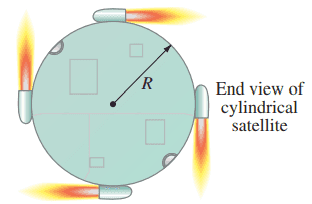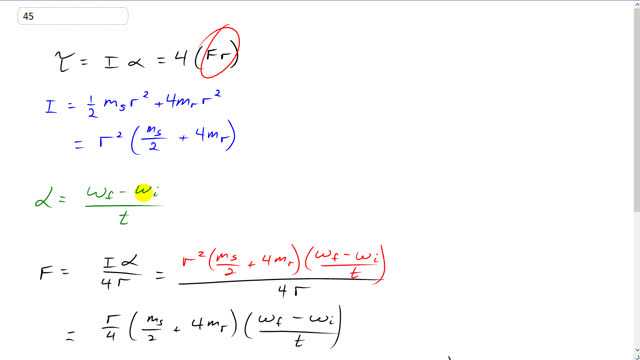
To get a flat, uniform cylindrical satellite spinning at the correct rate, engineers fire four tangential rockets as shown in Fig. 8–50. Suppose that the satellite has a mass of 3600 kg and a radius of 4.0 m, and that the rockets each add a mass of 250 kg. What is the steady force required of each rocket if the satellite is to reach 32 rpm in 5.0 min, starting from rest?


In order to watch this solution you need to have a subscription.
This is Giancoli Answers with Mr. Dychko. The total net torque needed to accelerate the satellite is its moment of inertia times its angular acceleration and that's gonna equal 4 times the torque applied by each rocket. So each rocket has a force F times a lever arm r and there's four of them so times by 4 to get the total torque of all of them. The moment of inertia of the system is gonna be moment of inertia of the uniform disk one-half mass of the satellite times its radius squared plus the moment of inertia of each of the rocket's which is gonna be a total of 4 of them times mass of the rocket times r squared— that's the moment of inertia formula for a point mass— and you can factor out the r squared and you get moment of inertia is r squared times the mass of the satellite over 2 times 4 times the mass of a single rocket. The angular acceleration will be the final angular velocity minus the initial angular velocity over the time it takes to make that change in angular velocity. And well then we can substitute those things into this after we rearrange it by solving for F. So we'll divide both sides by 4r and we get F is moment of inertia times angular acceleration divided by 4 times radius and then we'll substitute for moment of inertia with r squared and that's over 2 plus 4 times mass of a rocket and then also substitute for α—angular acceleration—by writing final angular velocity minus initial over time and that's all divided by 4r. And one of the r's will cancel here leaving us with just a single r to the power of 1 over 4 times all this stuff here and then we can plug in some numbers. So we have 4 meters divided by 4 times 3600 kilograms—mass of the satellite— divided by 2 plus 4 times—the mass of a single rocket— 250 kilograms then we convert the 32 revolutions per minute into radians per second by multiplying by 1 minute for every 60 seconds and then times by 2π radians per revolution and then divide by the time expressed in seconds by multiplying 5 minutes by 60 seconds per minute and we get about 31 newtons is the force applied by each rocket.